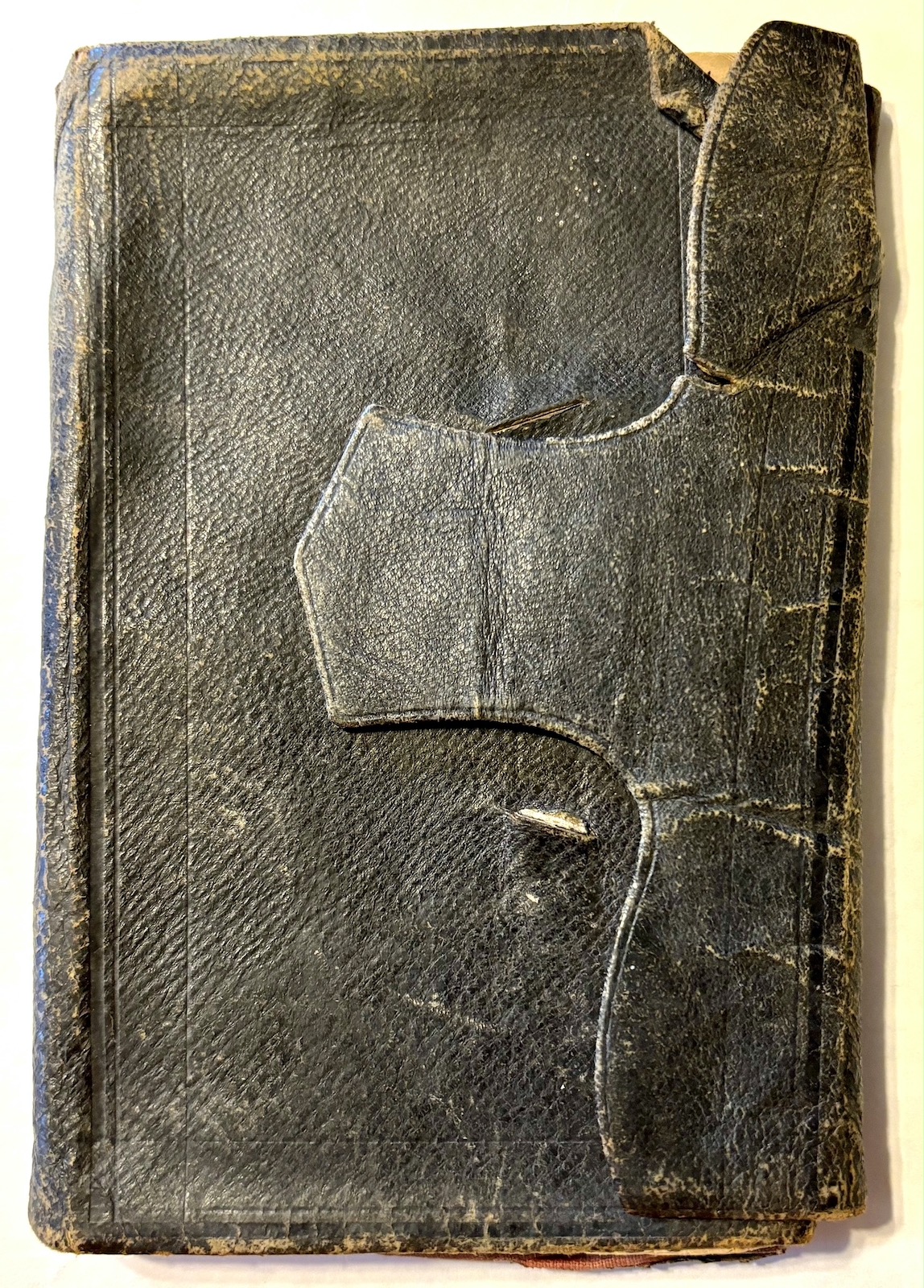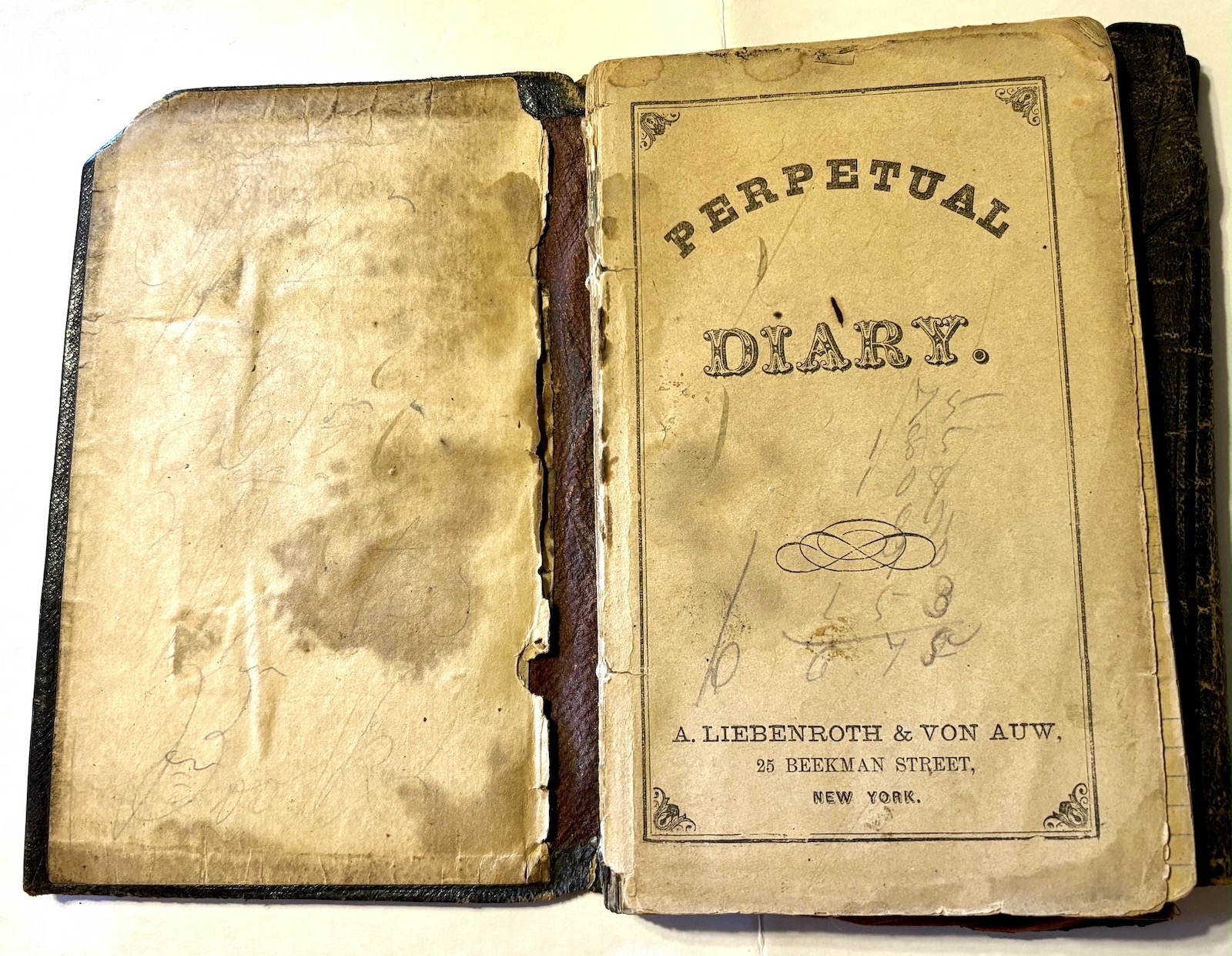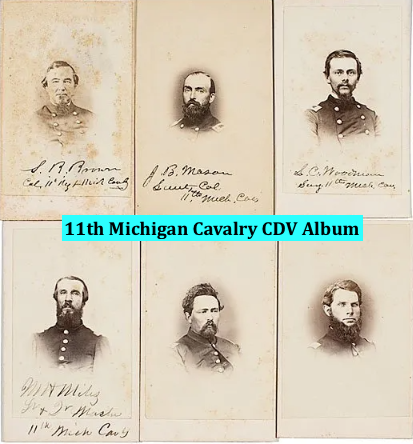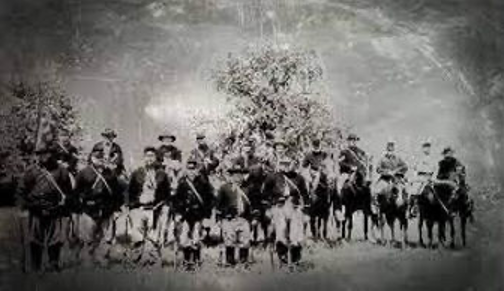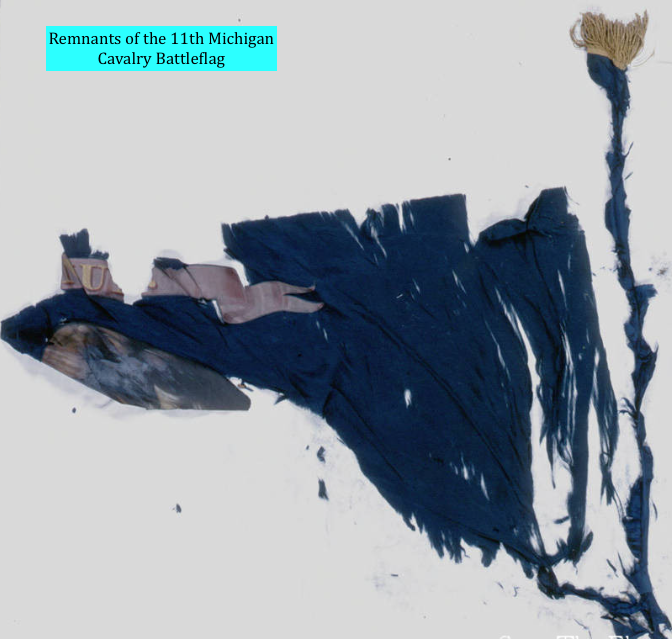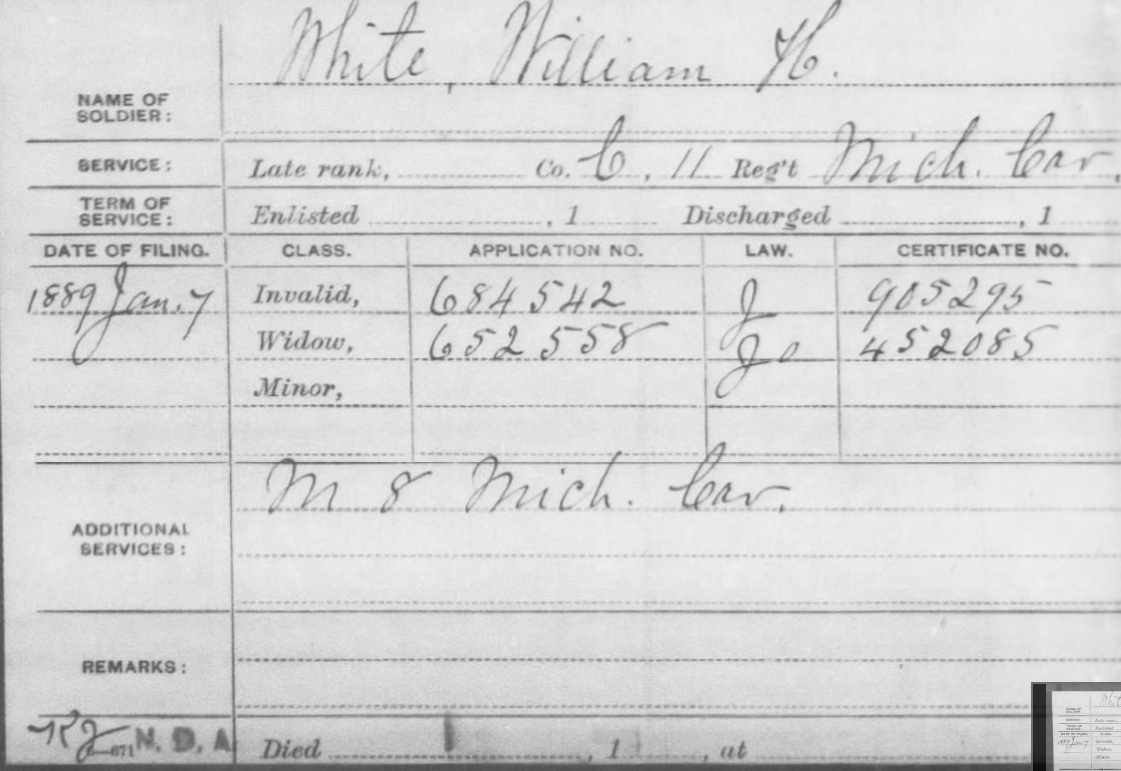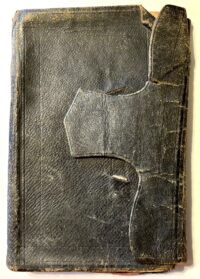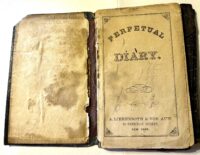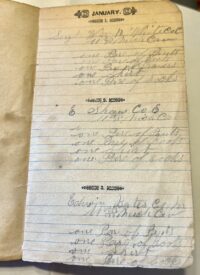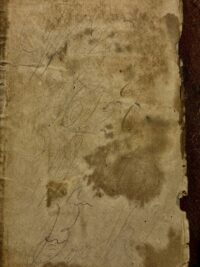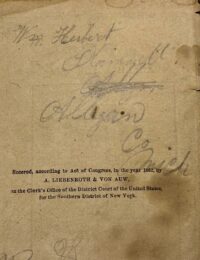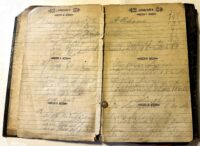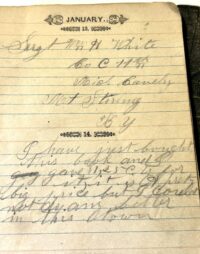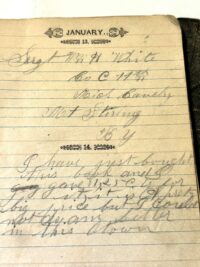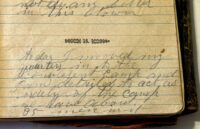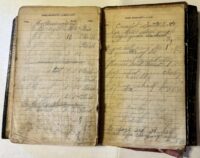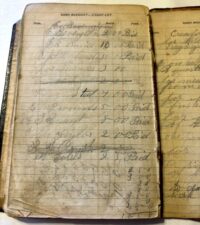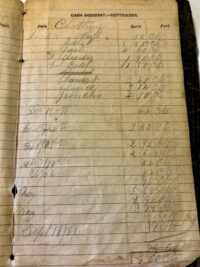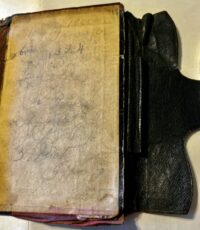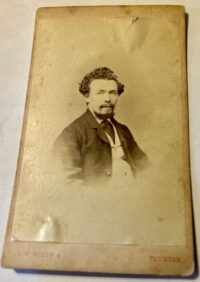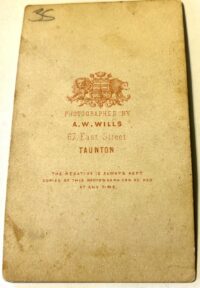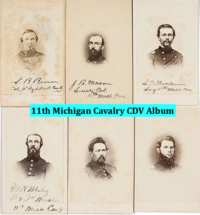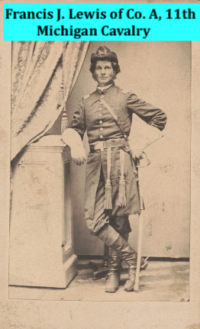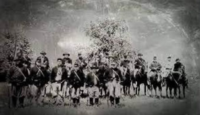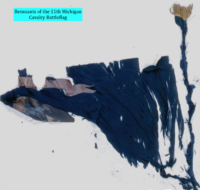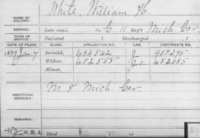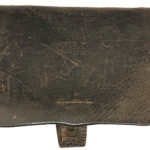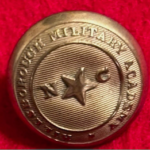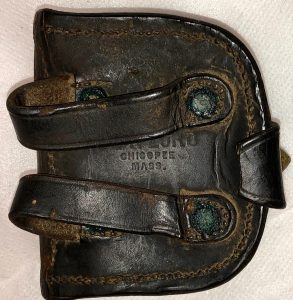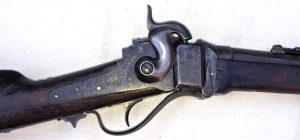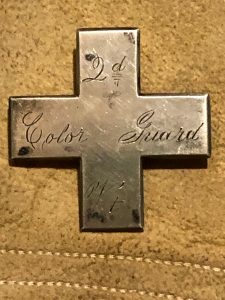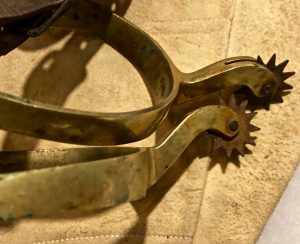Wartime Diary of Sergeant William H. White, Co. C 11th Michigan Cavalry
SOLD
Wartime Diary of Sergeant William H. White, Co. C 11th Michigan Cavalry – Completed by Sergeant William H. White of Co. C, 11th Michigan Cavalry, this diary encompasses January, 1864 through September, 1864. The latter months of the diary, exhibiting just a few daily entries, served as a ledger for Sgt. White, containing a list of Army payments made to soldiers in his company, as well as a list of equipment and clothing issues. The diary entries detail, for the most part, daily activities and weather; although the 11th Michigan Cavalry was quite active in 1864, there is little discussion of combat episodes. The 11th Michigan Cavalry participated in pursuit of Confederate General John Hunt Morgan’s men, as well as a successful attack on the Saltville, Virginia, Confederate, salt works, two forays with Gen. Stoneman, engagements at McCormack’s Farm and Laurel Mountain; the regiment was commended by General Burbridge for “gallant conduct” in action. The diary, copyrighted in 1862, is housed in a black, leather book like cover, which remains in excellent, pliable condition. There is a pocket and pencil sleeve in the back of the diary. Sergeant White’s name appears in several locations in the diary; on the interior, paper lining of the front cover, lightly inscribed in pencil, is: “W. H. Whites Book”. All entries in the diary are in pencil; the vast majority, with the exception of a few that have been smudged by period, weather conditions, are highly legible. When we obtained the diary, there was a CDV of a Union soldier, wearing what appears to be a military sack coat and a linen vest; we are unsure if this is Sgt. White.
Measurements: H – 5.75”; W – 4”
William H. White
| Residence was not listed; 25 years old.
Enlisted on 9/9/1863 at Campbell, MI as a Sergeant. On 9/23/1863 he mustered into “C” Co. MI 11th Cavalry He was transferred out on 7/20/1865 at Pulaski, TN On 7/20/1865 he transferred into “M” Co. MI 8th Cavalry He was Mustered Out on 9/22/1865 at Nashville, TN |
| Name | William H White |
| Enlistment Age | 25 |
| Birth Date | abt 1838 |
| Enlistment Date | 9 Sep 1863 |
| Enlistment Place | Campbell, Michigan |
| Enlistment Rank | Sergeant |
| Muster Date | 23 Sep 1863 |
| Muster Place | Michigan |
| Muster Company | C |
| Muster Regiment | 11th Cavalry |
| Muster Regiment Type | Cavalry |
| Muster Information | Enlisted |
| Muster Out Date | 20 Jul 1865 |
| Muster Out Place | Pulaski, Tennessee |
| Muster Out Information | Transferred |
| Side of War | Union |
| Survived War? | Yes |
| Additional Notes 2 | Muster 2 Date: 20 Jul 1865; Muster 2 Place: Michigan; Muster 2 Unit: 1077; Muster 2 Company: M; Muster 2 Regiment: 8th Cavalry; Muster 2 Regiment Type: Cavalry; Muster 2 Information: Transferred; MusterOut 2 Date: 22 Sep 1865; MusterOut 2 Place: Nashville, Tennessee; MusterOut 2 Information: Mustered Out; |
11th MI Cavalry
( 3-years )
| Organized: Kalamazoo, MI on 10/10/63 Mustered Out: 7/20/65 at Pulaski, TNOfficers Killed or Mortally Wounded: 4 Officers Died of Disease, Accidents, etc.: 0 Enlisted Men Killed or Mortally Wounded: 24 Enlisted Men Died of Disease, Accidents, etc.: 114 (Source: Fox, Regimental Losses) |
| From | To | Brigade | Division | Corps | Army | Comment |
| Apr ’64 | Jul ’64 | 1 | 1 | District of Kentucky | Army and Dept of Ohio | |
| Jul ’64 | Feb ’65 | 4 | 1 | District of Kentucky | Army and Dept of Ohio | |
| Mar ’65 | Jun ’65 | 2 | Gillem’s Cav | District East TN | Department of Cumberland | |
| Jun ’65 | Jul ’65 | 1 | Gillem’s Cav | District East TN | Department of Cumberland | Cons with 8th MI Cav |
Organized at Kalamazoo and Detroit during the fall of 1863, the regiment was sent to Kentucky where it performed security and scouting duties based at Lexington through the spring of 1864 riding in pursuit of John Hunt Morgan. The 11th transferred to Camp Burnside in August 1864 and participated in the Saltville expedition in Virginia made infamous by the murderous depreciations of bushwhacker Champ Ferguson. Later in October the regiment was engaged at McCormack’s Farm and Laurel Mountain and was commended by General Burbridge for “gallant conduct” in action. The Michigander’s rode in Stoneman’s Raid in Southwest Virginia before going into winter quarters at Lexington. Moving to Knoxville, Tennessee in February 1865 the regiment rejoined Stoneman for a raid into southwest Virginia and western North Carolina skirmishing in at least eight engagements before ending the war at Asheville. The regiment garrisoned in Pulaski, Tennessee and was consolidated with 8th Michigan Cavalry, in July, 1865 having lost 28 officers and men in combat.
MICHIGAN
Eleventh Cavalry
The Eleventh was organized at Kalamazoo and was mustered
| into the service of the United States Dec. 10, 1863.
The field, staff and line officers at organization were as follows:
Colonel, Simeon B. Brown, St. Clair. Lieutenant Colonel, James B. Mason, Battle Creek. Majors, Charles E. Smith, Oshtemo, and Henry L. Wise, Caledonia. Surgeon, Lucius C. Woodman, Paw Paw. Assistant Surgeons, O. J. Bissell, Grand Rapids, and Charles A. Osborne, Northville. Adjutant, Manly S. Rowley, Niles. Quartermaster, Marcus H. Miles, St. Clair. Commissary, Charles Kendall, Kalamazoo. Chaplain, Charles Clutz, Grand Rapids.
A. Captain, David W. Phillips, Albion. First Lieutenant, John L Frisbie, Hillsdale. Second Lieutenant, Francis J. Lewis, Albion.
B. Captain, George J. West, Lexington. First Lieutenant, Charles Simpson, Owosso. Second Lieutenant, William L. M. Osborn, Adrian.
C. Captain, Edwin C. Miles, St. Clair. First Lieutenant, Charles A. Bailey, Hastings. Second Lieutenant, Matthew B. Burger, Odessa.
D. Captain, Adna H. Bowen, Monroe. First Lieutenant, John Edwards, Hudson. Second Lieutenant, W. Baker Thompson, Hudson.
E. Captain, Restcome R. Kirby, Monroe. First Lieutenant, Amos J. Avery, Lasalle. Second Lieutenant, Adrian C. Solean, Frenchtown.
F. Captain, Darwin D. Buck, Battle Creek. First Lieutenant, Thomas H. Jennings, Battle Creek. Second Lieutenant, John G. Harris, Battle Creek.
G. Captain, James E. Merritt, Tecumseh. First Lieutenant, James Gilluly, Ann Arbor. Second Lieutenant, Newell H. Rowlingson, Battle Creek.
H. Captain, Henry Bowen, Adrian. First Lieutenant, Willard Stearns, Franklin. Second Lieutenant, Clark W. Decker, Adrian.
I. Captain, William H. George, Bolivia. First Lieutenant, Edwin Robbins, Kalamazoo. Second Lieutenant, James P. Cadman, Kalamazoo.
K. Captain, George M. Wells, Niles. First Lieutenant, James Ward, Lansing. Second Lieutenant, George F. Anderson, Litchfield.
L. Captain, William H. Jordan, Kalamazoo. First Lieutenant, Edmund B. Chamberlain, Kalamazoo. Second Lieutenant, George W. Cutler, Ransom.
M. Captain, John L. Frisbie, Hillsdale. First Lieutenant, Abram E. Stowell, Coldwater. Second Lieutenant, Martin S. Perkins, Coldwater.
The Eleventh left Kalamazoo for Kentucky Dec. 17, 1863, with an enrollment of 920 officers and men. It arrived at Lexington Dec. 22 and the headquarters of the regiment remained there until April, 1864.
During these months the different companies of the regiment were not idle, but took part in many scouts and skirmishes and the regiment made a reconnoissance to Pound Gap and met the confederate General Clay’s forces at West Liberty.
During the month of April the Eleventh moved to Louisa, Ky., where it was placed in the First Brigade, First Division, Army of the Ohio, and did active service in expelling the lawless guerrillas and bandits from the eastern part of the state.
The confederate raider, John Morgan, entered the state in May and the Eleventh, with the balance of the brigade, started in pursuit. Morgan was overtaken at Mt. Sterling, Ky., June 9, and was driven in confusion from the town. He was again overtaken at Cynthiana, Ky., June 12, where a severe engagement was fought, completely routing Morgan’s forces and driving them into the mountains.
In September the regiment participated in the raid into Western Virginia under General Burbridge for the purpose of destroying the extensive salt works located at Saltville, Va.
These works were the largest in the confederacy and the confederate government took ample means to guard and protect them, for their destruction would mean a severe loss to the southern armies.
General Burbridge’s forces consisted of less than 5,000 mounted men and six pieces of artillery, while General Breckenridge in command at Saltville, had upwards of 25,000 men well placed behind strong fortifications.
General Burbridge’s march was rapid through a broken and mountainous country and he reached the salt works October 2, after skirmishing with the enemy almost continually while in the mountains.
The three brigades of the union troops were sent forward in a charge upon the enemy’s works, the points of attack being at different places, but they were so vastly outnumbered by the Confederates who stood behind their intrenchments that the charge was hopeless. It was made with spirit and dash, but was soon repulsed, the Eleventh losing in killed, wounded and missing, 86 men. Lieutenant Colonel Mason, who led the regiment, was killed.
The Eleventh returned to Lexington, Ky., about the middle of October, after having suffered many privations and hardships during the raid.
During the month of November it was constantly in the saddle, skirmishing with the enemy in a number of widely separated places and arrived at Crab Orchard November 20. From this point it made a long march across the Cumberland Mountains, and proceeded through Cumberland Gap to Bean Station, Tenn., where it arrived the first of December.
The weather was very cold and the men suffered severely during the inclement season. The regiment was constantly on duty, fording rivers, climbing mountains, and fighting the enemy. The 11th of December the Eleventh joined the forces under General Stoneman on a raid into North Carolina.
During this raid the Union troops met the Confederates under General Vaughan near Abington and routed his command, taking 250 prisoners and a large amount of artillery.
The command then proceeded to Mt. Airy and Max Meadow Station, and commenced the destruction of a large amount of property and one arsenal, belonging to the Confederate government.
Union troops had not visited this section of the country and vast stores of corn and other supplies awaiting shipment to Richmond were burned.
The whole command then made a rapid march upon Saltville, Va., and finally reached the place after severe fighting, and accomplished what had been attempted many times before.
For two days the destruction of the works continued. Over 2000 kettles were broken, the wells filled with railroad iron and solid shot, and buildings burned. Three forts, two arsenals filled with ammunition, 13 cannon, 5 locomotives and 80 cars, the depot and store houses were destroyed.
After the complete destruction of the salt works the regiment returned, beating off the enemy who followed closely, and arrived safely, although three-fourths of the command had become dismounted, their horses having succumbed to the severe marching without forage.
In January, 1865, the regiment was at Lexington, Ky., and started for Knoxville, Tenn., to join General Stoneman’s command in an expedition through the Southern Confederacy.
General Stoneman left Knoxville March 17, and passed rapidly through Boon, N. C., crossed the Yadkin river on the 30th and during the first days of April destroyed the East Tennessee railroad at Christiansburg, and reached Salisbury, N. C., April 12, where he fought a heavy force of the enemy, capturing 1,800 prisoners and 22 pieces of artillery.
From Salisbury, rapid marches were made through North and South Carolina, destroying large amounts of public property on the way. It arrived at Carnesville, Ga., May 1, and captured a portion of the cavalry escort of Jefferson Davis, near Washington, on the 11th.
On the 22d the Eleventh crossed the Savannah river, reached Ashville, N. C., the 25th, Greenville, Tenn., the 27th, Knoxville June 3d, and Pulaski, July 20, where it was consolidated with the Eighth Michigan Cavalry.
The officers and men were mustered out with the Eighth Cavalry at Nashville, Tenn., Sept. 22, 1865, and returned to Jackson, Mich., Sept. 28, 1865.
The regiment was engaged with the enemy at Pound Gap, Ky., May 17, 1864; Hazel Green, Ky., May 20, 1864; Mount Sterling, Ky., June 9, 1864; Lexington, Ky., June 10, 1864; Georgetown, Ky., June 13, 1864; Cynthiana, Ky., June 12, 1864; Point Burnside, Ky., August 30, 1864; McCormick’s Farm, Ky., September 23, 1864; Laurel Mountain, Va., September 29, 1864; Bowen’s Farm, Va., September 30, and October 1, 1864; Saltville, Va., October 2, 1864; Sandy Mountain, Va., October 3 and 4, 1864; Western Virginia, October 5, 1864; Hazel Green, Ky., November 9, 1864; McCormick’s Farm, Ky., November 10, 1864; Morristown, Ky., November 13, 1864; State Creek, Ky., November 14, 1864; Mt. Sterling, Ky., November 16, 1864; Clinch River, Tenn., November 28, 1864; Russellville, Tenn., December 1, 1864; Morristown, Tenn., December 1, 1864; Cobb’s Ford, Tenn., December 2, 1864; Bristol, Tenn., December 13, 1864; Paperville, Tenn., December 13, 1864; Abingdon, Va., December 15, 1864; Wytheville, Va., December 16, 1864; Mount Airy, Va., December 17, 1864; Marion, Va., December 18, 1864; Seven Miles Ford, Va., December 19, 1864; Saltville, Va., December 20 and 21, 1864; Jonesboro, Va., December 23, 1864; Clinch River, Va., December 24, 1864; Morristown, Va., December 25, 1864; McCormick’s Farm, Ky., December 29, 1864; Mt. Sterling, Ky., Jan. 19, 1865; Hazel Green, Ky., January 28, 1865; Flemingsburg, Ky., February 18, 1865; Boone, N. C., March 27, 1865; Yadkin River, N. C., March 28, 1865; Mount Airy, Va., March 31, 1865; Hillsville, Va., April 1, 1865; Salem, Va., April 3, 1865; Christiansburg, Va., April 3, 1865; Jonesboro, Tenn., April 5, 1865; Danbury, N. C., April 9, 1865; Statesville, N. C., April 10, 1865; ford near Statesville, N. C., April 11, 1865; Salisbury, N. C., April 12, 1865; Statesville, N. C., April 13, 1865; Morgantown, N. C., April 16, 17, 18, 1865; Swananoa Gap, N. C., April 19, 1865; Hendersonville, N. C., April 21, 1865; Asheville, N. C., April 23, 1865; Ward’s Farm, N. C., April 28, 1865; Caesar’s Head, S. C., April 30, 1865; Pickensville, S. C., May 1, 1865; Anderson Court House, S. C., May 2, 1865.
Total enrollment…………………………………….1375 Killed in action………………………………………18 Died of wounds…………………………………………5 Died in confederate prisons……………………………..2 Died of disease……………………………………….22 Discharged for disability (wounds and disease)……………55 |
11th Regiment, Michigan Cavalry
OVERVIEW:
Organized at Kalamazoo and Detroit, Mich., October 7 to December 10, 1863. Moved to Lexington, Ky., December 10-22, 1863, and duty there till April 28, 1864. Attached to District of Lexington, Ky., 23rd Army Corps, Army of the Ohio, to April, 1864. 1st Brigade, 1st Division, District of Kentucky, 5th Division, 23rd Army Corps, Dept. of the Ohio, to August, 1864. 4th Brigade, District of Kentucky, Dept. of the Ohio, to February, 1865. 2nd Brigade, Cavalry Division, District of East Tennessee, Dept. of the Cumberland, to July, 1865.
SERVICE:
Moved from Lexington to Louisa, Ky., April 28-May 3, 1864, and duty scouting and patrolling in Eastern Kentucky till May 25. Expedition from Louisa to Rockhouse Creek May 9-13 (Cos. “A,” “F”). Pound Gap May 9 (Cos. “A,” “F”). Pursuit of Morgan May 25-June 20. Mt. Sterling June 9. Duty at Lexington, Ky., till August 23. Moved to Camp Burnside, on the Cumberland River, August 23, and duty protecting southern borders of Kentucky till September 16. Burbridge’s Expedition to Saltsville, Va., September 17-October 20. McCormack’s Farm September 23. Laurel Mountain, Va., September 29. Cedar Bluffs September 30. Bowen’s Farm September 80-October 1. Saltsville October 2. Sandy Mountain October 3. Regiment complimented by Gen. Burbridge for gallant conduct in cutting its way through greatly superior numbers when completely surrounded by the forces of Gen. Cerro Gordo Williams. Operations against guerrillas near Mt. Sterling till November 17. Moved to Crab Orchard November 17-20, thence to Cumberland Gap, Tenn. Scout to Morristown December 1-4. Stoneman’s Raid to Southwest Virginia December 10-29. Paperville and Kingsport December 13. Bristol December 14. Abington, Va., December 15. Wytheville December 16. Marion December 17-18. Saltsville December 20-21. Duty at Lexington, Ky., till February 23, 1865. Moved to Knoxville, Tenn., February 23-March 15. Stoneman’s Expedition from East Tennessee in Southwet Virginia and Western North Carolina March 21-April 25. Boone N. C., March 28. Danbury, N. C., April 9. Shallow Ford and near Mocksville April 11. Salisbury April 12. Catawba River, near Morgantown, April 17. Blue Ridge Mountains, Howard’s Gap, April 22. Hudsonville April 23. Asheville April 25. Moved to Pulaski, Tenn., June 24, and duty there till July. Consolidated with 8th Michigan Cavalry July 20, 1865.
Regiment lost during service 4 Officers and 24 Enlisted men killed and mortally wounded and 114 Enlisted men by disease. Total 142.
11th Michigan Cavalry Regiment
| 11th Michigan Cavalry Regiment | |
| Active | October 7, 1863 – July 20, 1865 |
| Disbanded | July 20, 1865 |
| Country | United States |
| Allegiance | Union |
| Branch | Cavalry |
| Size | Regiment |
| Engagements | American Civil War |
| Commanders | |
| Colonel | Simeon B. Brown |
| 1st Lieutenant | Willard Sterns |
| 2nd Lieutenant | Clark W. Decker |
Service
The 11th Michigan Cavalry was organized at Kalamazoo and Detroit, Michigan October 10 and December 10, 1863. Among its ranks was future Michigan politician and author Elroy M. Avery.
The Regiment was part of General George Stoneman’s campaign into eastern Tennessee, western Virginia, North Carolina, and South Carolina in 1865. The 11th Michigan Cavalry was one of three regiments in the Second Brigade of Col. Simeon B. Brown of St. Clair. Engagements: In Kentucky: Hazel Green, McCormick’s Farm, Morristown, State Creek, Mt. Sterling, Cynthiana, June 8–9, Point Burnside, June 30, 1864. In Tennessee: Clinch River, Nov.28; Cobb’s Ford, Dec. 2: Bristol, Dec. 13; Paperville, Dec. 13, 1864. In Virginia: Abingdon, Dec. 15; Wytheville lead mines, Mt. Airey, Marion iron works, Seven Miles Ford, Mount Sterling, Sept. 17; Saltville I, October 1–3, 1864, Union defeat.(Saltville Massacre); Sandy Mountain, Marion, December 17–18, 1864; Saltville II, December 18–21, 1864, destroyed salt works; After Saltville, returned to Knoxville; arrived Dec. 28, 1864; Departed Knoxville, March 16–21, 1865; Morristown, March 24; Jonesboro, March 25. Crossing into North Carolina and heading south, they conducted a series of raids on sites manufacturing goods vital to Lee’s troops—Boone, March 28–29 destroyed Patterson yarn mill below Blowing Rock; Yadkin River; Wilkesboro, March 30; Jonesville, April 1; Mount Airy, April 2; Christiansburg, VA, April 3; Danbury, April 9 destroying the Moratock Iron Works; Salisbury, April 12 (Destroyed prison); Statesville, April 13–16 (Taylorsville, April 14); April 14, Lincoln assassination; Morganton, April 17–19; Marion, April 20; Swannanoa Gap, (the Army was blocked there and went around to Howard’s Gap) April 20; Hendersonville, April 24 ; Asheville, April 25–28; Marshall, April 26; Ward’s Farm; Left Brevard, pushing through Saluda Gap in the Blue Ridge, they entered South Carolina, looking for Jefferson Davis. Caesar’s Head, April 30; Pickensville, Anderson’s Court House.
The regiment was consolidated with the 8th Michigan Volunteer Cavalry Regiment on July 20, 1865. Mustered out at Nashville Tennessee on September 22, 1865.
Total strength and casualties
Company H enlisted men, 106. Total regimental enrollment 1,579. The regiment suffered 4 officers and 24 enlisted men killed in action or mortally wounded and 114 enlisted men who died of disease, for a total of 142 fatalities.
The Last Cavalry Regiment From Michigan, the Proud Eleventh
by Gordon Thorsby
Veterans were proud of the regiments they served in during the Civil War, but they were more proud of the country they served for and the cause of freedom. The Eleventh Michigan Cavalry was not famous but what it contributed toward an end of the war was significant. They were a late war, mustered in latter 1863. The regiment suffered over 10% deaths in casualties, 28 from battle and 114 from disease. More than 200 were wounded in battle and 128 who became prisoners of war.
One of the veterans was John Quincy Adams. A quite presidential name given John by his father, Squire, and his mother, Ruthala. John was born November 29, 1845 in Romulus, Michigan. He grew up in the town west of Detroit that was a rail stop on the way to and from Jackson and eventually Chicago. Two months prior to his eighteenth birthday, Quincy as he was sometimes called, enlisted in Company E of the 11th Michigan Cavalry at Ypsilanti as private and Bugler.
The eleventh’s initial role in early 1864 was to gain experience since Confederate cavalry had been veterans for two years. The troopers gained that experience by patrolling behind the lines to prevent guerilla raids in eastern Kentucky on supply depots and rail lines. Starting in 1862, Confederate Brigadier General John Hunt Morgan raided into the north terrifying supply lines and northern towns. Morgan had to be stopped and it was at Cynthiana on June 9-12, 1864, the 11th Michigan took a significant role in the action that routed Morgan’s force and drove them into the mountains and ultimately Morgan’s death.
In September through mid-October, A joint expedition was begun with a force of just under 5,000 troopers including two new colored regiments of cavalry on a raid to Saltville, VA with the objective to destroy the saltworks mine (largest in the South and protected by 25,000 men.) The raid ended in disaster and the Eleventh Cavalry suffered 86 casualties (including the regiment’s commander) in killed, wounded and missing.
In the freezing and drizzling cold of mid-December, the 11th Cavalry joined in a raid to North Carolina, in the direction of Abington, VA resulting in taking 250 prisoners and an undetermined number of artillery. With this mission accomplished, they moved on to Mt. Airy where Union troops had never been and where badly needed supplies awaited shipment for Lee’s Army of Northern Virginia. These supplies were put to the torch while Lee’s troops were starving in the trenches at Petersburg. With the mission fully accomplished, they moved on to revisit Saltville.
The first time being unsuccessful, the 11th returned in another attempt on Saltville. They had to fight their way in under heavy firing but when achieved, they went to work for two straight days. Troopers filled the wells with rail iron, solid cannon shot and anything that would prevent salt production. The three forts that protected the works were destroyed along with two ammunition arsenals, thirteen guns, five locomotives and over 80 rail cars. The smoke was noticeable for miles. With their mission complete, egress was as difficult as ingress. As rapid as the force moved to get back to base, Confederate troops aggressively pursued. Stoneman’s force did return home but it wasn’t in the same condition as it left. The horses had broken down or died due to forced speed, distance and a lack of forage. Over three fourths of the troopers returned on foot and cavalry as infantrymen was not the ideal mode of travel for a trooper in any army.
The regiment rested, refitted and transferred to Tennessee where they joined another raid under Maj. General George Stoneman to slice through North Carolina. In the 11th Michigan cavalry’s final raid of the War, they started in East Tennessee and proceeded east into North Carolina destroying military supplies. As Stoneman was tearing North Carolina from the west, Maj. Gen. William Tecumseh Sherman simultaneously marched his army north through the Carolinas. Stoneman’s raiding force reached Salisbury (near Charlotte) on April 12th, where in heavy fighting, Stoneman’s force took 1,800 prisoners, and 22 artillery guns. They continued south destroying public property and eventually reached Carnesville, GA. Their last act on May 1, was in skirmishing and eventually capturing a portion of Confederate Jefferson Davis’ escort cavalry.
In latter may, the Eleventh was assigned to Gillem’s Cavalry with the need to strike guerilla bands that raided in the eastern Kentucky. In June, the 11th patrolled remote areas in northern Mississippi performing similar roles of scouting, guarding and raiding to keep guerilla activity at a minimum.
With the war now over, cavalry was still needed to patrol the Southern states against guerilla violence. The Eleventh Michigan was mustered out and disbanded on July 20, 1865 at Pulaski, TN, but John Quincy’s term of enlistment was not up yet. He was transferred into Company K of the Eighth Michigan cavalry. The 8th had seen some hard service in the Atlanta Campaign in the Summer of 1864. A large number of men had been captured and sent to Andersonville. The 8th Michigan was mustered out at Nashville on September, 22, 1865, the men transported to Jackson, were paid off and disbanded.
For John, he took a short rail trip back home and the war was over. He never traveled far from other War veterans as he was member of Penoyer GAR post #90 in Saginaw after his marriage. In life after the war, he married Mary Frances Chambers, 24, in 1872 and after her death in 1901, John married Ida Fairchild. John passed away on October 25, 1927 in Saginaw. at 81 years of age. Today, he lies next to Mary.


